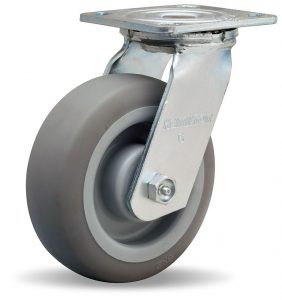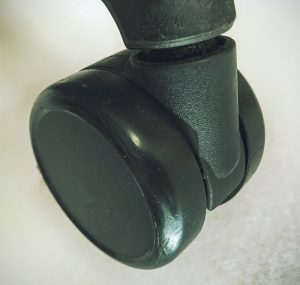Health and safety regulations
The primary example of the benefits of using casters is to reduce the risk of workplace injuries for its users, particularly overexertion. Overexertion occurs when the caster being used is not suited for the application, mainly due to the wrong wheel material or rig, causing injury to the user.
There are many health and safety organizations that enforce and regulate the allowable forces and noise levels that casters can make on a plant floor, and include the Canadian Centre for Occupational Health and Safety (CCOHS), Occupational Safety and Health Administration (OSHA). For example, CCOHS recommends that the maximum horizontal force someone should exert is 50 lbf. Liberty Mutual has also produced a Snook Table that provides the percent population of male and female able to push at a given horizontal force. This force can be adjusted to a safe level by providing the right caster wheel material and rig.
To ensure the design integrity of casters, the Institute of Caster and Wheel Manufacturers (ICWM) working in collaboration with the American National Standards Institute (ANSI) has developed the ANSI ICWM: 2012 The ICWM Performance Standard for Casters and Wheels which is intended to provide manufacturers, specifiers and users with a common basis for evaluating the safety, durability, structural adequacy and technical requirements for group specific casters and wheels.
Caster flutter
One major disadvantage of casters is flutter. A common example of caster flutter is on a supermarket shopping cart, when one caster rapidly swings side-to-side. This oscillation, which is also known as shimmy, occurs naturally at certain speeds, and is similar to speed wobble that occurs in other wheeled vehicles. The speed at which caster flutter occurs is based on the weight borne by the caster and the distance between the wheel axle and steering axis. This distance is known as trailing distance, and increasing this distance can eliminate flutter at moderate speeds. Generally, flutter occurs at high speeds.
What makes flutter dangerous is that it can cause a vehicle to suddenly move in an unwanted direction. Flutter occurs when the caster is not in full contact with the ground and therefore its orientation is uncontrollable. As the caster regains full contact with the ground, it can be in any orientation. This can cause the vehicle to suddenly move in the direction that the caster is pointed. At slower speeds, the caster’s ability to swivel can correct the direction and can continue travel in the desired direction. But at high speeds this can be dangerous as the wheel may not be able to swivel quickly enough and the vehicle may lurch in any direction.
Electric and racing wheelchair designers are very concerned with flutter because the chair must be safe for riders. Increasing trailing distance can increase stability at higher speeds for wheelchair racing, but may create flutter at lower speeds for everyday use. Unfortunately, the more trail the caster has, the more space the caster requires to swivel. Therefore, in order to accommodate this extra swivel space, lengthening of frame or extending the footrests may be required. This tends to make the chair more cumbersome.
Caster flutter can be controlled by adding dampers or increasing the friction of the swivel joints. This can be accomplished by adding washers to the swivel joint. The friction increases as the weight on the front of the chair increases. Anytime the caster begins to flutter, it slows the chair and shifts weight to the front wheels. There are several online anti-flutter kits for retrofitting wheelchair casters in this manner. Other methods of reducing caster flutter include increasing swivel lead, using heavier grease, reducing the mass of the wheel, or increasing friction with the ground by changing materials.
Casters are also stopped completely using caster cups.


